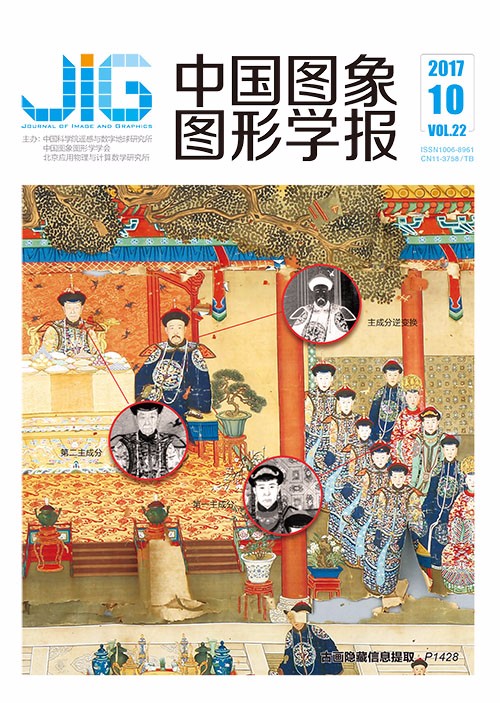
结合全卷积网络和GrowCut的肾皮质分割算法
摘 要
目的 肾脏图像分割对于肾脏疾病的诊断有着重要意义,临床上通过测量肾皮质的体积和厚度可判断肾脏是否有肿瘤、慢性动脉硬化性肾病和肾移植急性排斥反应等。现有的肾脏分割算法大多针对一种模态,且只能分割出肾脏整体。本文提出一种基于全卷积网络和GrowCut的肾皮质自动分割算法,用于多模态肾脏图像分割。方法 首先用广义霍夫变换对肾脏进行检测,提取出感兴趣区域,通过数据增强扩充带标签数据;然后用VGG-16预训练模型进行迁移学习,构建适用于肾皮质分割的全卷积网络,设置网络训练参数,使用扩充数据训练网络。最后用全卷积网络分割图像,提取最后一层卷积层的特征图得到种子点标记,结合肾脏图像的先验知识纠正错误种子点,将该标记图作为GrowCut初始种子点可实现肾皮质准确分割。结果 实验数据为30组临床CT和MRI图像,其中一组有标记的CT图像用于训练网络并测试算法分割准确性,该文算法分割准确率IU(region intersection over union)和DSC(Dice similarity coefficient)分别达到91.06%±2.34%和91.79%±2.39%。与全卷积网络FCN-32s相比,本文提出的网络参数减少,准确率更高,可实现肾皮质分割。GrowCut算法考虑像素间的邻域信息,与全卷积网络结合可进一步将分割准确率提高3%。结论 该方法可准确分割多模态肾脏图像,包括正常和变异肾脏的图像,说明该方法优于主流方法,能够为临床诊断提供可靠依据。
关键词
Renal cortex segmentation with fully convolutional network and GrowCut
Shi Yonggang, Qian Mengyao, Liu Zhiwen(School of Information and Electronics, Beijing Institute of Technology, Beijing 100081, China) Abstract
Objective Kidney segmentation plays an important role in the diagnosis of kidney diseases.The volume and thickness of renal cortex are effective assessment criteria in early clinical diagnosis for renal neoplasms,chronic arteriosclerotic nephropathy,and acute rejection after kidney transplant.However,most existing methods focus on the whole kidney segmentation.This paper presents a fully automatic renal cortex segmentation based on fully convolutional network and GrowCut for multi-modality kidney images.Method Generalized Hough Transform(GHT) is used to detect non-analytic shape represented by R-table.GHT localizes the kidney and then the region of interest(ROI) is extracted.The fully convolutional network(FCN-32s) for semantic segmentation is introduced into renal cortex segmentation.Data augmentation is employed to expand labeled data and transfer learning is applied due to lack of sufficient training data.The initial parameters of the proposed network are taken from pre-trained model of VGG-16.All the fully connected layers of VGG-16 are converted into convolutional layers.The filter size of fc8 is changed from 1 000 to 2 because the proposed network regards cortex and background as two classes.The filter sizes of fc6 and fc7 are modified from 4 096 into 1024 to reduce parameters.Pooling and down-sampling layers can extract more abstract features for image classification tasks.For image segmentation,however,too much trivial information will be lost.The proposed network retains the first three pooling layers of VGG-16.Dropout,as a regularization method,prevents over-fitting,and loss function is optimized with Stochastic Gradient Descent.The proposed network is a first implementation for realizing renal cortex segmentation based on the fully convolutional network.However,the obvious disadvantage of fully convolutional network is that it is a pixel-wise classification and does not consider the spatial relationship among pixels.It will cause some unexpected results.The segmentation regions have burrs at the edge,and cortex of some slices is missegmented.The proposed method combines fully convolutional network and GrowCut for superior cortex segmentation.GrowCut is an interactive segmentation method based on the labeled seeds,and the pixels compete to gain labels in the neighborhood.The performance of GrowCut relies on the initial seeds marked by the user.In this paper,the seeds are generated by the proposed network,which realizes an automatic implementation and frees manual interventions.The images of test set are firstly segmented by the proposed network,and the feature maps of the last convolutional layer are extracted as a labeled map.The mislabeled seeds that always appears in spine,spleen,and other adjacent tissues can be corrected by GrowCut with priors of kidney.GrowCut can achieve more accurate cortex segmentation based on the correctly labeled map.A set of contrast-enhanced CT images and corresponding ground truth labeled by experts is given for training fully convolutional network.The ROI will be normalized after it is extracted from the original image,and then expanded after cutting and reflections.These images are split into a training set(5 000) and a validation set(300).Parameters of the network will be adjusted in the training processing.The proposed network is trained on a deep learning framework Caffe,with maximum iteration of 10 000,initial learning rate of 0.001,which is multiplied by 0.1 at every 2 000 interactions,momentum of 0.9,weight delay of 0.000 5,and batch size of 1 for online learning.The proposed network is quantitatively compared with three pre-trained fully convolutional networks by three metrics:pixel accuracy,overall accuracy,and mean region intersection over union(IU).The proposed method is compared with four methods,including two fully convolutional networks and two typical methods.Two metrics are used,namely,IU and Dice Similarity Coefficient(DSC),which is a common metric in medical image segmentation.Result The experimental dataset contains 30 clinical CT and MRI images.The proposed method achieved IU of 91.06%±2.34% and DSC of 91.79%±2.39%.The proposed fully convolutional network has fewer parameters and higher accuracy than basic fully convolutional network for renal cortex segmentation.GrowCut algorithm considers the neighborhood information between pixels,thus further improving the segmentation accuracy by 3%.Results show that contrast-enhanced and non-contrast-enhanced images can be accurately segmented.Conclusion Deep learning model trained with huge data set of natural images can extract hierarchical features and can be introduced in medical images segmentation by transfer learning.Missegmentation is reduced by the proposed network and can be corrected effectively.The experimental results indicate that the proposed method is more suitable for kidney images from different modalities and outperforms typical methods.The proposed method can provide a reliable basis for clinical diagnosis because medical images from normal and abnormal kidneys both can be segmented accurately.The furture work includes the following tasks:the accuracy of non-contrast-enhanced image segmentation will be further improved by optimizing algorithm;the proposed network will be used for segmentation of other organs by fine-tuning the parameters of network.GrowCut will be plugged in the network as a new layer to perform end-to-end training.
Keywords
renal cortex segmentation fully convolutional network CrowCut VGG-16 transfer learning data augmentation
|



 中国图象图形学报 │ 京ICP备05080539号-4 │ 本系统由
中国图象图形学报 │ 京ICP备05080539号-4 │ 本系统由